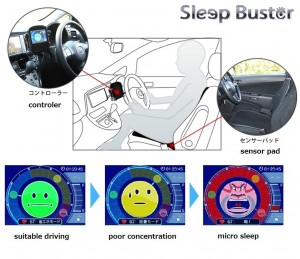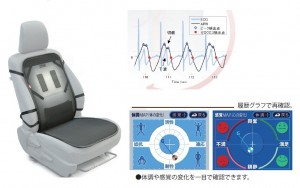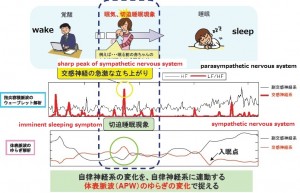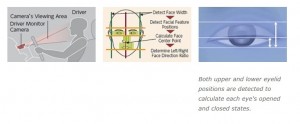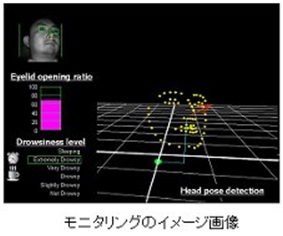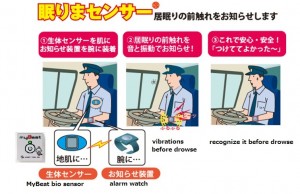Kikuo Hayakawa, NOST Tokyo
Origineel gepubliceerd op de site van Agentschap NL.
Vorig jaar ontstond er in Japan veel commotie over een verkeersongeluk, dat veroorzaakt werd door een slaperige vrachtwagenbestuurder. De Japanse overheid is daarom dit jaar begonnen met het stimuleren van anti-slaperigheidsystemen in vrachtauto’s.
Op dit moment zijn er verschillende systemen gereed. Eén van deze systemen is de Sleep Buster, die ontwikkeld werd door Delta Tooling Co. in samenwerking met professor Shigehiko Kaneko van de University of Tokyo. Deze Sleep Buster ontdekt in een vroeg stadium de symptomen van slaperigheid bij een bestuurder door zijn hartslag te meten via een sensor in de autostoel.
Ook andere bedrijven, zoals Toyota en Denso hebben antislaperigheidsystemen ontwikkeld. Toyota heeft dit systeem geïntegreerd in zijn antibotsingsysteem en Denso zal volgend jaar een dergelijk systeem lanceren specifiek voor de nieuwe auto’s van Japanse autobedrijven.
Details
In Japan there were 665,138 traffic accidents including 4,411 fatalities in 2012. (1) According to National Police Agency, the fatal accidents are caused by careless driving including drowsy driving and distracted driving, which are the top two reasons.
Recently in Japan, serious traffic accidents have occurred. In April 2012, seven passengers travelling by bus on a highway ended up dead, caused by a drowsy driver. Influenced by this accident, the Japanese Ministry of Land, Infrastructure, Transport and Tourism (MLIT) has subsidized the introduction of anti-drowsiness systems by carriers such as transport truck companies. The budget including other related ICT systems is 7.7 million euro for this year. Anti-drowsiness systems have been developed by Delta Tooling, Toyota, Aisin Seiki, Denso, Trywin and German Bosch. When it comes to collision avoidance systems, all heavy-duty trucks with more than twenty two tons have to be equipped with the systems in Japan, based on new regulations effective after November 2013. In Japan, more than 30,000 trucks are sold a year, almost half of which have a load capacity of more than twenty two tons. Therefore, roughly half of the trucks will be sold with collision avoidance systems after November 2014. Japanese truck company Hino Motors developed its new heavy-duty truck, Profia, equipped with a world- first collision warning and collision avoidance system in 2006. The technology is called ‘Pre-Crash Safety’, which was developed by Toyota. For cars, Fuji Heavy Industries (Subaru) developed a first camera-based collision warning and avoidance system, Eyesight, for application in the ‘Legacy’ in Japan in 2008. (2) Currently, collision warning and collision avoidance systems are already common in new cars sold in Japan. Most auto companies, including Subaru and Toyota, have developed their cars fitted with different collision avoidance systems.
Sleep Buster
Sleep Buster has been developed by a Japanese company Delta Tooling Co., based in Hiroshima, in cooperation with Prof. Shigehiko Kaneko of the Department of Mechanical Engineering of the University of Tokyo. (3) Sleep Buster is a new anti-drowsiness system which can detect symptoms before a driver becomes drowsy by monitoring the heartbeat from a driver’s car seat (Fig.1). Sleep Buster monitors driver’s heartbeat by picking up signals with a microphone sensor in the driver’s seat. It analyses aorta pulse waves (APW) of heartbeats once per eighteen seconds (Fig. 2). Driver’s APW changes the frequency and peak patterns, depending on mental conditions such as stress and drowsiness. Sleep Buster can detect a driver’s drowsy symptom ten minutes before the drive actually becomes drowsy. When it detects the symptoms, the controller screen of Sleep Buster shows a micro sleep alarm with a red face (Fig.1). It shows a green face during a stable driving. When it detects distracted driving (or careless driving), it shows a yellow face. There are seven different faces in total showing each mental status. According to Prof. Kaneko, everyone shows an imminent sleeping symptom before falling asleep, based on the sympathetic nervous system (Fig.3). (4) For instance, babies have a higher body temperature just before falling asleep. This is due to the sympathetic nervous system. Sleep Buster has a database of the relations between imminent sleeping symptoms and patterns of driver’s APW. Therefore it give warnings of imminent drowsiness. (5) JUKI Corp. is a company which is selling Sleep Buster. In April 2013, Sleep Buster received a technology award from the Japanese Ministry of Science and Technology. So far, Sleep Buster is the only anti-drowsiness system approved by MLIT to get a subsidy this year. It costs 1,210 euro per unit. Funded by the subsidy, it becomes half the price.
Figure 1. Sleep Buster system (source: JUKI, Delta Tooling)
Figure 2. Sensor seat and driver’s mental and body status for Sleep Buster (source: JUKI, Delta Tooling)
Figure 3. Phenomena of imminent sleeping symptom and drowse (source: JUKI, Delta Tooling)
Toyota’s driver monitoring systems
Toyota developed a world- first collision warning and collision avoidance system, Pre-Crash Safety, using millimeter-wave radar in 2003, and later developed a new Pre-Crash Safety with driver monitoring system in 2006. The Pre-Crash Safety with driver monitoring systems includes a function to monitor the driver’s eyes using an onboard camera with infra-red. It detects the direction of driver’s face. It also detects whether the driver’s eyes are open. And it alerts a driver with an early warning beep, and its auto-braking system reduces the car’s speed if it detects the driver is drowsy (Fing.4). (6) This system has been applied for Toyota’s cars such as the Crown. Hino Motors, the truck company under the Toyota group, developed its new heavy-duty truck, Profia, equipped with Toyota’s Pre-Crash Safety with driver monitoring system in 2006. (7) The camera systems for the driver monitoring system, used by Toyota and Hino, are supplied by a Japanese auto parts company Aisin Seiki. Aisin Seiki is developing the new generation of driver monitoring systems including sensors equipped in the seat which can measure breathing and heart beat and other devices, warning the driver and stopping the car, when breathing is paused for a while. Aisin will release it in the near future.
Figure 4. Pre-Crash safety system monitoring driver’s eyes (source: Toyota)
Denso’s new anti-drowsiness system
Denso is an auto parts company of the Toyota group. Denso has been developing a new driver monitoring system using information of the direction eyes , nose and eyebrows move (Fig. 5). The directions of a driver’s face show correct driving or not. It monitors an eye opening ratio as well, which can indicate dangerous driving or not. The system will has six levels showing of the amount of drowsiness. Denso’s new system will be released through a Japanese truck company before Tokyo Motor Show 2013 between November 23- December 1. Next year, it will be released by Denso, according to Denso’s Mr Masashi Izutsu.
Figure 5. Demonstration of Denso’s face recognition systems (source: Denso)
Other developments related anti-browse systems
In Europe, the German company Bosch has developed a steering wheel motion monitoring system in 2010. The system can detect driver exhaustion, monitoring the movement of a car’s steering. This includes drowsy driving. This system is used for automobiles such as Volkswagen’s Passat. A company Mobileye, based in the Netherlands, has developed a new collision warning and collision avoidance system, EyeQ. It monitors the distance of obstacles detected by the camera of EyeQ. Already a million of the systems were successfully sold. (8) A Japanese company Trywin has developed a portable system ‘Dramoni’ (Fig. 9). It monitors signals from the spinal cord using a pressure sensor in the driver’s seat. It costs 344 euro per unit. A small company Takanoaha developed a unique product ‘Inemuran’ (or Nap Vieeb ) It alerts drivers when his head inclines for reasons including a drowse (fig. 10). Anti-drowsiness system ‘Nemurima-sensor’ is developed by a company Toack in cooperation with Union Tool Co. The heartbeat bio sensor MyBeat is developed by Union Tool. When the system detects symptoms of falling into a drowsy state, the alarm watch receives a wireless signal from the bio sensor, and it warns and vibrates to let a driver know about a risk of falling asleep.
Figure 6. Driving monitor, Dramoni (source: Trywin Co.)
Figure 7. Inemuran (source: TAKANOAHA)
Figure 8. Anti-drowsiness system ‘Nemurima-sensor’ (source: Toack)
Currency:
1 euro = 130 yen (as of August 29, 2013)
Sources:
1) Intelligent Transport Systems on logistics, IA netwerk.
2) Latest technologies of no-collision vehicles, Nikkei4946.com, February 2, 2013 (in Japanese).
3) University of Tokyo Professor Shigehiko Kaneko, Dept. of Mechanical Engineering.
5) Sleep Buster press release meeting, JUKI and Delta Tooling (in Japanese).
6) Toyota Pre-Crash Safety System.
7) Hino Adds Driver Monitor to the Pre-Crash Safety System for “Hino Profia” Heavy-Duty Trucks.

